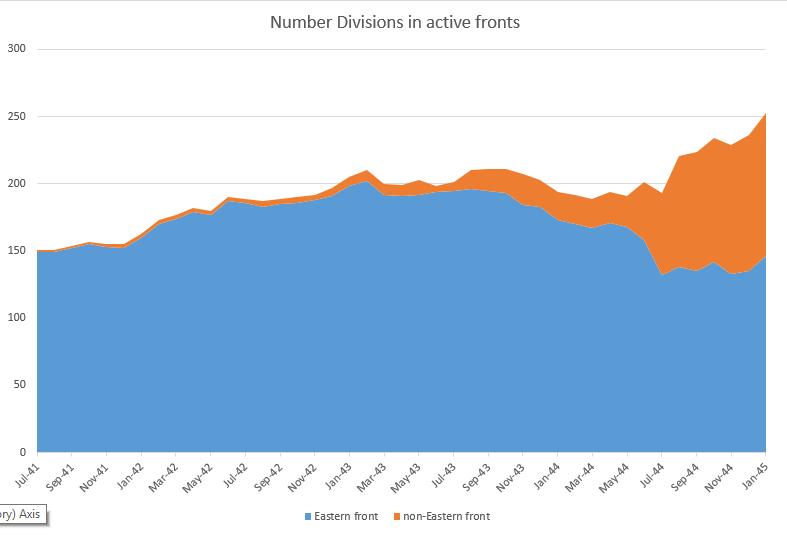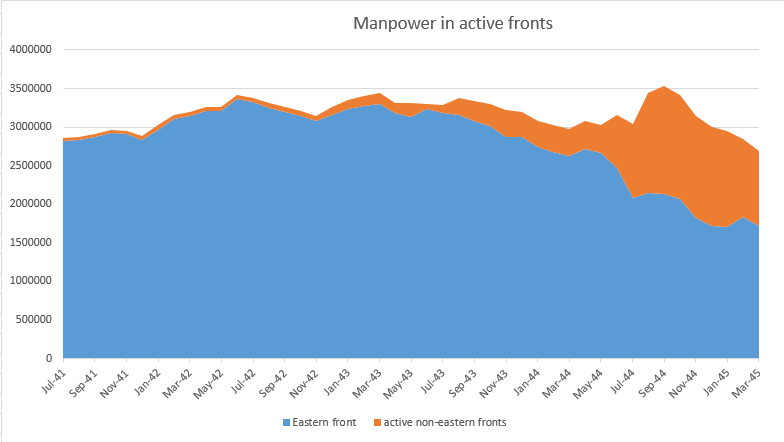Including losses of the air-force and the navy, the Wehrmacht lost 1,153,470 soldiers killed in action in the Eastern front and 178,552 soldiers killed in the western front, Italy, North Africa and Mediterranean combined. That's 86.6% of KIA in the Eastern front in all branches of the armed forces combined.
If you analyse it by the distribution of Heer and Waffen-SS divisions we have the following:

And excluding the divisions in inactive fronts (like Norway, the Western front before June 1944, etc), and including only divisions in fronts were there was systematic combat we have the following:

From mid 1941 up to the end of 1944, on average, 89.2% of all frontline divisions were in the Eastern front. During the decisive years of 1941 up to mid 1943, 98% of the Wehrmacht frontline ground forces were in the Eastern front, decreasing to 94%-88% with the opening of the Italian front. With the opening of the Western front, based on Zetterling's analysis that only 37 divisions out of the 66 divisions were deployed in combat in Normandy, I made the following assumption: in June 1944, 1/4 of all divisions were assumed to be frontline, in July, 1/2 of all divisions were assumed to be fronline, un August, 3/4 of all divisions were frontline and 100% were frontline in september.
Using KDF33's data on the size of field army (http://forum.axishistory.com/viewtopic. ... 2#p1987572), I assumed each point was a "midyear" (yes I know it's not rigorous but I am working with the data I have) and assumed a monthly decrease of 180,000 personnel after mid 1944. This way I adjusted the size of the divisions by the total size of the field army to get an idea of the total manpower in the frontlines:

On average 90.1% of the frontline manpower was in the Eastern front from mid 1941 to the end of 1944. Interestingly, the decline in manpower in the Eastern front began in mid 1943 and was continuous afterwards.
Soviet advance was almost continuous from the Battle of Stalingrad onwards, it's speed did not increase after the opening of the Western front although in mid 1943 the opening of the Italian front mean 20 German frontline divisions there which decreased manpower for the Eastern front by about 10%, the only period of German territorial recovery/stalemate after Stalingrad in the Eastern front was from march-july 1943, just before the Italian landings. But overall, it appears to me that the decline in manpower in the Eastern front overall is more a function of German casualties than redeployments outside of the Eastern front from the opening of new fronts.
Soviet advances in 1943 and 1944:

Overall, it appears to me that by far the most important Western allied strategic contribution was the fact that even in 1941 to mid 1943, the Wehrmacht had ca. 60-70 divisions stationed outside of it to defend against possible Allied landings over Europe.
Indeed from June 1941 to the end of December 1944 we had:
66% of the Wehrmacht in the Eastern front.
26.5% of the Wehrmacht in non-active fronts.
7.5% of the Wehrmacht in active fronts outside of the Eastern front.
The inactive fronts were much more important than the active fronts in just diverting Wehrmacht manpower outside of the Eastern front. Considering that the bulk of the Wehrmacht expenditures were with personnel and not munitions or equipment that means that a large fraction of total military outlays went to the non-active fronts. This implies that strategically the greatest contribution the western allies did was not strategic bombing (which did not affect total German industrial production significantly until late 1944), nor the invasion of Italy or France, it was the threat of invasion itself.